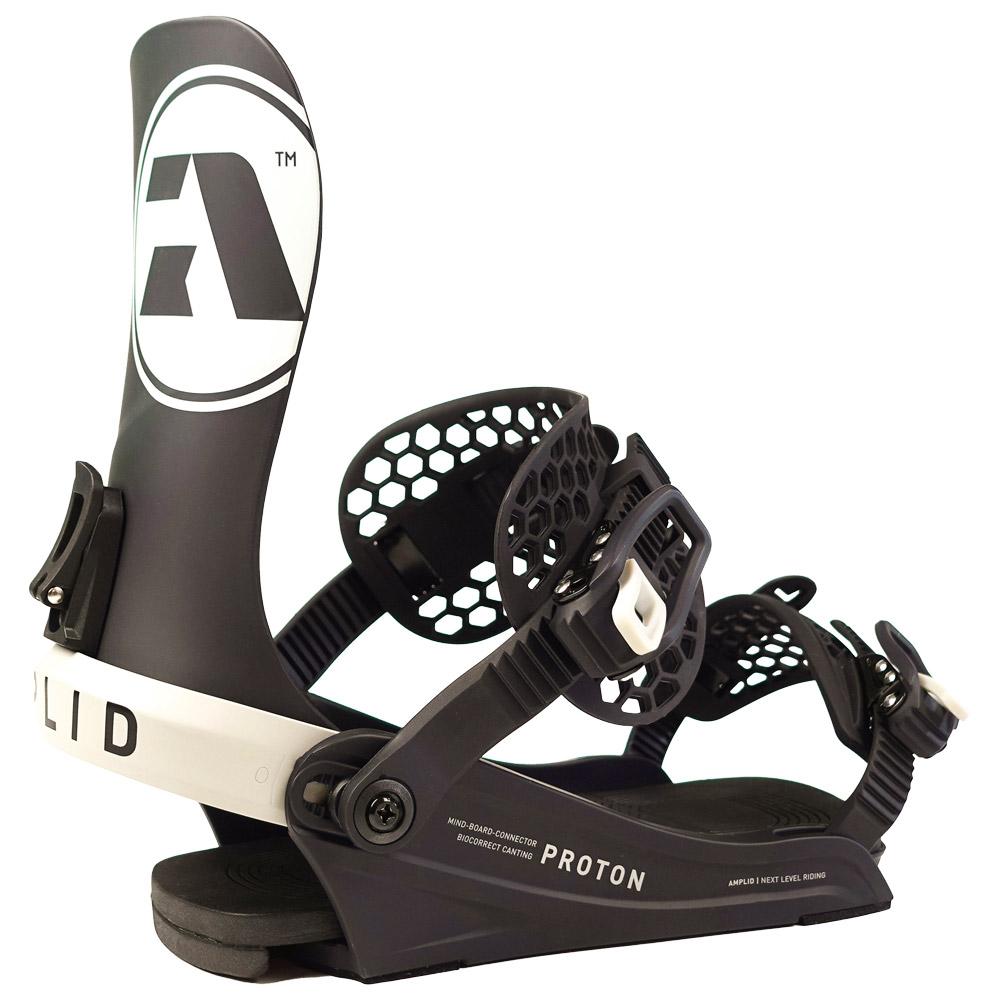58879724
Proton Black
https://www.glisshop.co.uk/snowboard-bindings/amplid/proton-black58879724
Amplid
Men
Women
Winter 2025
58879724
The Amplid Proton is a high-performance, comfortable snowboard binding, ideal for all-mountain freeriding, offering increased precision and shock absorption, perfect for intermediate to advanced riders.
https://glisshop-glisshop-fr-storage.omn.proximis.com/Imagestorage/imagesSynchro/0/0/0d09bb96e1cb6fb5d0e086b30440b211d0341e3c_H25AMPLBIN4473391_0.jpeg
https://glisshop-glisshop-fr-storage.omn.proximis.com/Imagestorage/imagesSynchro/0/0/cb6c041fc6039f8384ea375362fd3a84ab57c570_H25AMPLBIN4473391_1.jpeg
https://glisshop-glisshop-fr-storage.omn.proximis.com/Imagestorage/imagesSynchro/0/0/7e1b700e80f877e52f1b0abdec72bf7f952472e3_H25AMPLBIN4473391_3.jpeg
https://glisshop-glisshop-fr-storage.omn.proximis.com/Imagestorage/imagesSynchro/0/0/5a1556096695d3fb36f4149b99884ac154d095bc_H25AMPLBIN4473391_5.jpeg
https://glisshop-glisshop-fr-storage.omn.proximis.com/Imagestorage/imagesSynchro/0/0/494baad011ed82e135856c964dec36314349bd20_H25AMPLBIN4473391_6.jpeg
https://glisshop-glisshop-fr-storage.omn.proximis.com/Imagestorage/imagesSynchro/0/0/c40d64b6cc2d2d8838e67b051a66306dac8ac70f_H25AMPLBIN4473391_901.jpeg
https://glisshop-glisshop-fr-storage.omn.proximis.com/Imagestorage/imagesSynchro/0/0/4678ca929f748da54e346ed3d5b7e2cc09ac6e80_H25AMPLBIN4473391_902.jpeg
https://glisshop-glisshop-fr-storage.omn.proximis.com/Imagestorage/imagesSynchro/0/0/1cec4e8f25432ba02cef27398e7e7c2fba15d2a3_H25AMPLBIN4473391_903.jpeg
https://glisshop-glisshop-fr-storage.omn.proximis.com/Imagestorage/imagesSynchro/0/0/60416a90650d775df948e41f0363235c6c576012_H25AMPLBIN4473391_904.jpeg
https://glisshop-glisshop-fr-storage.omn.proximis.com/Imagestorage/imagesSynchro/0/0/f167756c2a6707e0d7b452e38e48f1cd1db86684_H25AMPLBIN4473391_905.jpeg
https://glisshop-glisshop-fr-storage.omn.proximis.com/Imagestorage/imagesSynchro/0/0/9231a68769f764e76bc7e60886a8cf85c253d018_H25AMPLBIN4473391_906.jpeg
https://glisshop-glisshop-fr-storage.omn.proximis.com/Imagestorage/imagesSynchro/0/0/14142146636be70ccc02306ad63749f86a1f5f4b_H25AMPLBIN4473391_907.jpeg
https://glisshop-glisshop-fr-storage.omn.proximis.com/Imagestorage/imagesSynchro/0/0/a2edbacc94662dbeee5c6a51f20927ca9a0ef713_H25AMPLBIN4473391_908.jpeg
InStock
175.41
GBP
251.01
GBP_VAT_royaume_uni
GBP_VAT_france
175.41
251.01
GBP
packs always have stock if there is a price
InStock
GBP_VAT_france_corse
175.41
251.01
GBP
packs always have stock if there is a price
InStock
GBP_VAT_espagne
176.87
251.01
GBP
packs always have stock if there is a price
InStock
GBP_VAT_italie
178.33
251.01
GBP
packs always have stock if there is a price
InStock
GBP_VAT_allemagne
173.95
251.01
GBP
packs always have stock if there is a price
InStock
GBP_VAT_pays_bas
176.87
251.01
GBP
packs always have stock if there is a price
InStock
GBP_VAT_belgique
176.87
251.01
GBP
packs always have stock if there is a price
InStock
GBP_VAT_suisse
158.02
251.01
GBP
packs always have stock if there is a price
InStock
GBP_VAT_suede
182.72
251.01
GBP
packs always have stock if there is a price
InStock
GBP_VAT_danemark
175.41
251.01
GBP
packs always have stock if there is a price
InStock
GBP_VAT_monaco
175.41
251.01
GBP
packs always have stock if there is a price
InStock
GBP_VAT_luxembourg
171.02
251.01
GBP
packs always have stock if there is a price
InStock
GBP_VAT_irlande
175.41
251.01
GBP
packs always have stock if there is a price
InStock
GBP_VAT_portugal
175.41
251.01
GBP
packs always have stock if there is a price
InStock
GBP_VAT_autriche
175.41
251.01
GBP
packs always have stock if there is a price
InStock
GBP_VAT_pologne
175.41
251.01
GBP
packs always have stock if there is a price
InStock
GBP_VAT_finlande
183.45
251.01
GBP
packs always have stock if there is a price
InStock
GBP_VAT_slovenie
175.41
251.01
GBP
packs always have stock if there is a price
InStock
GBP_VAT_france
175.41
251.01
GBP
packs always have stock if there is a price
InStock
GBP_VAT_france_corse
175.41
251.01
GBP
packs always have stock if there is a price
InStock
GBP_VAT_espagne
176.87
251.01
GBP
packs always have stock if there is a price
InStock
GBP_VAT_italie
178.33
251.01
GBP
packs always have stock if there is a price
InStock
GBP_VAT_allemagne
173.95
251.01
GBP
packs always have stock if there is a price
InStock
GBP_VAT_pays_bas
176.87
251.01
GBP
packs always have stock if there is a price
InStock
GBP_VAT_belgique
176.87
251.01
GBP
packs always have stock if there is a price
InStock
GBP_VAT_suisse
158.02
251.01
GBP
packs always have stock if there is a price
InStock
GBP_VAT_suede
182.72
251.01
GBP
packs always have stock if there is a price
InStock
GBP_VAT_danemark
175.41
251.01
GBP
packs always have stock if there is a price
InStock
GBP_VAT_monaco
175.41
251.01
GBP
packs always have stock if there is a price
InStock
GBP_VAT_luxembourg
171.02
251.01
GBP
packs always have stock if there is a price
InStock
GBP_VAT_irlande
175.41
251.01
GBP
packs always have stock if there is a price
InStock
GBP_VAT_portugal
175.41
251.01
GBP
packs always have stock if there is a price
InStock
GBP_VAT_autriche
175.41
251.01
GBP
packs always have stock if there is a price
InStock
GBP_VAT_pologne
175.41
251.01
GBP
packs always have stock if there is a price
InStock
GBP_VAT_finlande
183.45
251.01
GBP
packs always have stock if there is a price
InStock
GBP_VAT_slovenie
175.41
251.01
GBP
packs always have stock if there is a price
InStock
CHF_VAT_france
187.1
267.74
CHF
packs always have stock if there is a price
InStock
CHF_VAT_france_corse
187.1
267.74
CHF
packs always have stock if there is a price
InStock
CHF_VAT_royaume_uni
187.1
267.74
CHF
packs always have stock if there is a price
InStock
CHF_VAT_espagne
188.66
267.74
CHF
packs always have stock if there is a price
InStock
CHF_VAT_italie
190.22
267.74
CHF
packs always have stock if there is a price
InStock
CHF_VAT_allemagne
185.54
267.74
CHF
packs always have stock if there is a price
InStock
CHF_VAT_pays_bas
188.66
267.74
CHF
packs always have stock if there is a price
InStock
CHF_VAT_belgique
188.66
267.74
CHF
packs always have stock if there is a price
InStock
CHF_VAT_suisse
168.55
267.74
CHF
packs always have stock if there is a price
InStock
CHF_VAT_suede
194.9
267.74
CHF
packs always have stock if there is a price
InStock
CHF_VAT_danemark
187.1
267.74
CHF
packs always have stock if there is a price
InStock
CHF_VAT_monaco
187.1
267.74
CHF
packs always have stock if there is a price
InStock
CHF_VAT_luxembourg
182.43
267.74
CHF
packs always have stock if there is a price
InStock
CHF_VAT_irlande
187.1
267.74
CHF
packs always have stock if there is a price
InStock
CHF_VAT_portugal
187.1
267.74
CHF
packs always have stock if there is a price
InStock
CHF_VAT_autriche
187.1
267.74
CHF
packs always have stock if there is a price
InStock
CHF_VAT_pologne
187.1
267.74
CHF
packs always have stock if there is a price
InStock
CHF_VAT_finlande
195.68
267.74
CHF
packs always have stock if there is a price
InStock
CHF_VAT_slovenie
187.1
267.74
CHF
packs always have stock if there is a price
InStock
CHF_VAT_france
187.1
267.74
CHF
packs always have stock if there is a price
InStock
CHF_VAT_france_corse
187.1
267.74
CHF
packs always have stock if there is a price
InStock
CHF_VAT_royaume_uni
187.1
267.74
CHF
packs always have stock if there is a price
InStock
CHF_VAT_espagne
188.66
267.74
CHF
packs always have stock if there is a price
InStock
CHF_VAT_italie
190.22
267.74
CHF
packs always have stock if there is a price
InStock
CHF_VAT_allemagne
185.54
267.74
CHF
packs always have stock if there is a price
InStock
CHF_VAT_pays_bas
188.66
267.74
CHF
packs always have stock if there is a price
InStock
CHF_VAT_belgique
188.66
267.74
CHF
packs always have stock if there is a price
InStock
CHF_VAT_suisse
168.55
267.74
CHF
packs always have stock if there is a price
InStock
CHF_VAT_suede
194.9
267.74
CHF
packs always have stock if there is a price
InStock
CHF_VAT_danemark
187.1
267.74
CHF
packs always have stock if there is a price
InStock
CHF_VAT_monaco
187.1
267.74
CHF
packs always have stock if there is a price
InStock
CHF_VAT_luxembourg
182.43
267.74
CHF
packs always have stock if there is a price
InStock
CHF_VAT_irlande
187.1
267.74
CHF
packs always have stock if there is a price
InStock
CHF_VAT_portugal
187.1
267.74
CHF
packs always have stock if there is a price
InStock
CHF_VAT_autriche
187.1
267.74
CHF
packs always have stock if there is a price
InStock
CHF_VAT_pologne
187.1
267.74
CHF
packs always have stock if there is a price
InStock
CHF_VAT_finlande
195.68
267.74
CHF
packs always have stock if there is a price
InStock
CHF_VAT_slovenie
187.1
267.74
CHF
packs always have stock if there is a price
InStock
EUR_VAT_france
194.9
278.9
EUR
packs always have stock if there is a price
InStock
EUR_VAT_france_corse
194.9
278.9
EUR
packs always have stock if there is a price
InStock
EUR_VAT_royaume_uni
194.9
278.9
EUR
packs always have stock if there is a price
InStock
EUR_VAT_espagne
196.52
278.9
EUR
packs always have stock if there is a price
InStock
EUR_VAT_italie
198.15
278.9
EUR
packs always have stock if there is a price
InStock
EUR_VAT_allemagne
193.28
278.9
EUR
packs always have stock if there is a price
InStock
EUR_VAT_pays_bas
196.52
278.9
EUR
packs always have stock if there is a price
InStock
EUR_VAT_belgique
196.52
278.9
EUR
packs always have stock if there is a price
InStock
EUR_VAT_suisse
175.57
278.9
EUR
packs always have stock if there is a price
InStock
EUR_VAT_suede
203.02
278.9
EUR
packs always have stock if there is a price
InStock
EUR_VAT_danemark
194.9
278.9
EUR
packs always have stock if there is a price
InStock
EUR_VAT_monaco
194.9
278.9
EUR
packs always have stock if there is a price
InStock
EUR_VAT_luxembourg
190.03
278.9
EUR
packs always have stock if there is a price
InStock
EUR_VAT_irlande
194.9
278.9
EUR
packs always have stock if there is a price
InStock
EUR_VAT_portugal
194.9
278.9
EUR
packs always have stock if there is a price
InStock
EUR_VAT_autriche
194.9
278.9
EUR
packs always have stock if there is a price
InStock
EUR_VAT_pologne
194.9
278.9
EUR
packs always have stock if there is a price
InStock
EUR_VAT_finlande
203.83
278.9
EUR
packs always have stock if there is a price
InStock
EUR_VAT_slovenie
194.9
278.9
EUR
packs always have stock if there is a price
InStock
EUR_VAT_france
194.9
278.9
EUR
packs always have stock if there is a price
InStock
EUR_VAT_france_corse
194.9
278.9
EUR
packs always have stock if there is a price
InStock
EUR_VAT_royaume_uni
194.9
278.9
EUR
packs always have stock if there is a price
InStock
EUR_VAT_espagne
196.52
278.9
EUR
packs always have stock if there is a price
InStock
EUR_VAT_italie
198.15
278.9
EUR
packs always have stock if there is a price
InStock
EUR_VAT_allemagne
193.28
278.9
EUR
packs always have stock if there is a price
InStock
EUR_VAT_pays_bas
196.52
278.9
EUR
packs always have stock if there is a price
InStock
EUR_VAT_belgique
196.52
278.9
EUR
packs always have stock if there is a price
InStock
EUR_VAT_suisse
175.57
278.9
EUR
packs always have stock if there is a price
InStock
EUR_VAT_suede
203.02
278.9
EUR
packs always have stock if there is a price
InStock
EUR_VAT_danemark
194.9
278.9
EUR
packs always have stock if there is a price
InStock
EUR_VAT_monaco
194.9
278.9
EUR
packs always have stock if there is a price
InStock
EUR_VAT_luxembourg
190.03
278.9
EUR
packs always have stock if there is a price
InStock
EUR_VAT_irlande
194.9
278.9
EUR
packs always have stock if there is a price
InStock
EUR_VAT_portugal
194.9
278.9
EUR
packs always have stock if there is a price
InStock
EUR_VAT_autriche
194.9
278.9
EUR
packs always have stock if there is a price
InStock
EUR_VAT_pologne
194.9
278.9
EUR
packs always have stock if there is a price
InStock
EUR_VAT_finlande
203.83
278.9
EUR
packs always have stock if there is a price
InStock
EUR_VAT_slovenie
194.9
278.9
EUR
packs always have stock if there is a price
InStock
/Snowboard/Snowboard bindings
brand - 122124
109046 - GLIS_CHAR_SNOW_BINDING_ENTRY_SYSTEM_10055
109047 - GLIS_CHAR_SNOW_BINDING_CATEGORY_10063
211232 -
107027 - GLIS_NAME_TYPO_PRODUCT_26
211236 - GLIS_PROD_HIGHLIGHT_SEASON_40144
21127769 - 21127765
21127769 - 21127766









































